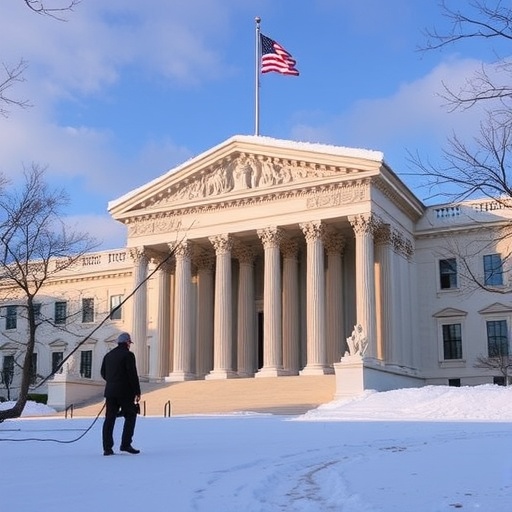US banking Regulators Scrap Climate Risk Principles Amid Mounting Political Pressure
In a stunning reversal that has sent shockwaves through the financial and environmental sectors, US banking regulators have abruptly withdrawn long-standing principles designed to address climate risk in the nation’s financial system. The move, announced late last week by the Office of the Comptroller of the Currency (OCC), the Federal Reserve, and the Federal Deposit Insurance Corporation (FDIC), comes just months after these agencies had reaffirmed their commitment to integrating climate considerations into financial oversight. Critics are decrying the decision as a clear capitulation to political pressure from Republican lawmakers and industry lobbyists, raising alarms about the vulnerability of America’s banks to escalating environmental threats.
- Behind the Scenes: How Political Pressure Derailed Climate Guidelines
- Cries of Foul Play: Environmental Groups and Experts Condemn the Reversal
- Ripple Effects on US Banking: Vulnerabilities Exposed Without Climate Safeguards
- Global Comparisons: US Lags as World Advances Climate-Integrated Finance
- Looking Ahead: Pathways to Rebuild Climate Resilience in American Finance
The principles, first introduced in 2020 and updated in 2023, urged banks to identify, assess, and manage risks posed by climate change, such as extreme weather events, shifting energy markets, and regulatory shifts toward sustainability. Their withdrawal signals a potential rollback in how US banking institutions prepare for a world increasingly battered by climate disasters. With wildfires raging in the West, floods devastating the Midwest, and hurricanes intensifying in the Gulf, the timing couldn’t be more precarious. This decision not only undermines years of regulatory progress but also leaves a gaping hole in the defenses of the $23 trillion US banking sector against foreseeable climate risk.
Environmental advocates and financial experts warn that this retreat could expose banks to massive losses—estimates from the Network for Greening the Financial System (NGFS) suggest that unmitigated climate risks could wipe out up to $2.5 trillion in global banking assets by 2030. In the US alone, the Federal Reserve’s own stress tests have highlighted how physical risks from climate events could strain bank balance sheets, yet now, without these guiding principles, regulators may lack the tools to enforce proactive measures.
Behind the Scenes: How Political Pressure Derailed Climate Guidelines
The withdrawal of the climate-risk principles didn’t happen in a vacuum; it was the culmination of intense political pressure orchestrated by conservative politicians and fossil fuel interests. Key figures in the Republican-led Congress, including House Financial Services Committee Chairman Patrick McHenry, had repeatedly targeted the guidelines as overreach by federal regulators. In a series of letters and hearings throughout 2023 and 2024, lawmakers argued that the principles burdened banks with unnecessary “woke” mandates, diverting focus from core economic growth.
One pivotal moment came in July 2024, when a coalition of 15 Republican attorneys general sent a stern warning to the OCC, FDIC, and Fed, threatening legal action if the agencies didn’t rescind the principles. “These guidelines represent an unlawful expansion of regulatory power, forcing banks to prioritize climate activism over sound financial practices,” read the letter, signed by AGs from states like Texas and Florida, home to major oil and banking hubs. Industry groups, such as the American Bankers Association (ABA), amplified this chorus, lobbying for deregulation to ease compliance costs estimated at $500 million annually for large institutions.
Insiders reveal that the pressure intensified after the November 2024 elections, with incoming administration officials signaling a broader anti-regulatory agenda. A former OCC official, speaking on condition of anonymity, told reporters, “It was clear the writing was on the wall. The agencies were caught between advancing public interest and avoiding a political firestorm.” This internal conflict echoes broader tensions in US banking regulation, where climate issues have become a partisan battleground.
To understand the depth of this political pressure, consider the funding trails: Over $100 million in campaign contributions from energy sectors flowed to supportive lawmakers in the 2024 cycle, according to OpenSecrets.org data. This financial influence has real-world implications, as banks like JPMorgan Chase and Bank of America, which hold trillions in fossil fuel financing, stand to benefit from lighter climate risk scrutiny.
Cries of Foul Play: Environmental Groups and Experts Condemn the Reversal
The backlash has been swift and fierce, with environmental organizations labeling the withdrawal a “dangerous gift to polluters.” The Sierra Club’s executive director, Michael Brune, issued a scathing statement: “In the face of record-breaking heatwaves and billion-dollar disasters, US regulators are abandoning their duty to protect our economy from climate risk. This is not just shortsighted—it’s a betrayal of future generations.”
Financial watchdogs echoed these sentiments. The Consumer Financial Protection Bureau (CFPB), while not directly involved, expressed concerns through a spokesperson: “Robust financial oversight must account for systemic threats like climate change; withdrawing these principles weakens our collective resilience.” Experts from Yale’s Program on Climate Change Communication pointed to recent events, such as the 2024 California wildfires that caused $50 billion in insured losses, as stark reminders of why banks need climate stress testing.
Internationally, the move has drawn ridicule. The European Central Bank’s climate chief, Frank Elderson, remarked in a Brussels panel, “While Europe advances with mandatory disclosures under the SFDR framework, the US retreat risks isolating its US banking sector from global standards.” A survey by PwC of 200 global finance leaders found 78% believe climate integration is essential for long-term stability, underscoring the US’s outlier status.
Critics also highlight hypocrisy: The same regulators who pulled the principles had, in 2023, conducted pilot climate scenario analyses on six major banks, revealing potential vulnerabilities in loan portfolios tied to carbon-intensive industries. “This data was just starting to inform better financial oversight,” said Dr. Emily Johnston, a climate economist at Columbia University. “Scrapping it now is like ignoring a fire alarm because it’s too hot in the room.”
Ripple Effects on US Banking: Vulnerabilities Exposed Without Climate Safeguards
For the US banking industry, the withdrawal means navigating uncharted waters without a compass for climate risk. Large banks, which manage over 70% of the sector’s $23 trillion in assets, now face heightened uncertainty. Consider the case of regional lenders in hurricane-prone areas: Without mandated risk assessments, institutions like those in Florida could underestimate flood-related defaults, potentially leading to a 2025 credit crunch if another Ian-scale storm hits.
Statistics paint a grim picture. The US Government Accountability Office (GAO) reported in 2024 that climate events have already cost the economy $150 billion annually, with banks absorbing 15-20% through non-performing loans. A Moody’s Analytics study warns that without regulatory nudges, banks might underprice risks in sectors like agriculture and real estate, where drought and sea-level rise pose existential threats.
Smaller community banks, often serving vulnerable populations, could suffer disproportionately. The Independent Community Bankers of America (ICBA) noted in a recent filing that while they welcome reduced bureaucracy, the lack of climate guidance leaves them ill-equipped for events like the 2023 Midwest floods, which spiked loan defaults by 12% in affected regions.
Moreover, investor pressure is mounting. BlackRock CEO Larry Fink, in his 2024 annual letter, urged banks to disclose climate risk exposures, warning that “sustainability is now a core driver of returns.” With $10 trillion in ESG assets under management in the US, shareholder activism could fill some regulatory voids, but it’s no substitute for systemic financial oversight.
- Key Vulnerabilities Highlighted: Physical risks (e.g., storms damaging collateral) and transition risks (e.g., stranded fossil fuel assets).
- Estimated Costs: Up to $1 trillion in US bank losses by 2050 without action, per NGFS models.
- Sector Impacts: Energy lending (40% of bank exposure) most at risk from policy shifts.
Global Comparisons: US Lags as World Advances Climate-Integrated Finance
While US banking regulators step back, the rest of the world is doubling down on climate-aware financial oversight. The Bank of England has embedded climate risk into its annual stress tests since 2021, simulating scenarios like a 4°C warming world that could erase 10% of UK bank capital. Similarly, China’s central bank mandates green finance reporting for all major lenders, channeling $500 billion into sustainable projects last year.
In the EU, the Corporate Sustainability Reporting Directive (CSRD) requires over 50,000 companies, including banks, to detail climate impacts starting in 2025. This has spurred innovation: Deutsche Bank, for instance, issued $1 billion in green bonds tied to low-carbon lending, boosting profitability by 15% in eco-portfolios.
The contrast is stark for US firms operating globally. Citigroup, with 40% of revenues from international markets, faces a patchwork of rules that could disadvantage it against peers like HSBC, which integrates NGFS scenarios into risk models. A World Bank report from 2024 estimates that countries with strong climate regulations see 20% lower financial volatility during environmental shocks.
US regulators aren’t entirely isolated; the SEC’s 2024 climate disclosure rule remains intact for public companies, but its scope excludes many private banks. As political pressure eases or shifts post-2026 midterms, advocates hope for a revival, perhaps through bipartisan infrastructure bills tying funds to resilience planning.
Looking Ahead: Pathways to Rebuild Climate Resilience in American Finance
As the dust settles on this regulatory U-turn, the path forward for US banking and climate risk management remains fraught but not hopeless. Industry leaders are already stepping up voluntarily: Goldman Sachs announced in January 2025 an internal climate risk framework, aiming to phase out $750 billion in high-carbon financing by 2030. “Regulation or not, climate is a material risk we can’t ignore,” said CEO David Solomon in a CNBC interview.
Congressional watchers predict legislative battles ahead. A bipartisan group of senators, led by Sheldon Whitehouse (D-RI) and Lisa Murkowski (R-AK), is drafting a bill to mandate federal regulators to incorporate climate scenarios in oversight, potentially gaining traction amid 2025’s wildfire season projections.
Financial innovators offer glimmers of hope. Fintech startups like ClimateTrade are developing AI tools for banks to model climate risk at low cost, with adoption rates climbing 30% year-over-year. International pressure via G20 commitments could also compel action, as the US risks reputational damage in global forums.
Ultimately, the withdrawal underscores a pivotal choice: Will political pressure continue to eclipse evidence-based financial oversight, or will mounting disasters force a course correction? With sea levels rising and temperatures soaring, the stakes for America’s economic backbone have never been higher. Banks, regulators, and policymakers must now innovate beyond mandates to safeguard prosperity in an uncertain climate.
(This article draws on official statements, expert analyses, and public data as of February 2025.)








